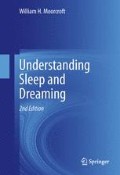Abstract
In order to fully understand sleep, it is necessary to understand the brain’s role in producing it. It used to be erroneously thought that the brain simply reduces its overall level of activity and arousal as the way to produce sleep. This chapter describes how the brain actively and purposely produces sleep. There are specific brain chemicals and brain areas that play critical roles in the production of waking, NREM sleep, and REM sleep. Part of this is a change in response to sensory input and the control of body movements. There are also specific chemicals and areas in the brain that are responsible for the circadian rhythm of sleep/wake. But the activity of local cells and of groups of cells in the cerebral cortex also influences sleep according to how active these cells have been during waking.
Specific references to statements in this chapter that can be found in multiple, widely available sources are not included in the text. A selection of these sources is listed below and can also be consulted for verification or more detail. (Amlaner and Fuller 2009; Chokroverty 2009; Kryger et al. 2011; Lee-Chiong 2011; Swick 2011).
Access this chapter
Tax calculation will be finalised at checkout
Purchases are for personal use only
Notes
- 1.
Fluid located in canals and spaces around and within the brain and spinal cord.
- 2.
The complete list of all substances that influence sleep and wake would be much longer, more complicated, and beyond the scope of this book. Even then, it is recognized that not everything has been discovered.
- 3.
Synapses are the gaps between the end of one neuron and the beginning of another.
- 4.
An older term for EEG activation is EEG desychronization.
- 5.
The switch on the wall that controls the room lights is an example of a flip-flop. It is either on or off.
- 6.
At this point, you may be questioning how an area of the brain that is important for waking is also key to sleeping. The answer is that in the brain, cells that perform one function may exist in the same area with cells that perform the opposite function because their communication with other neurons differs both in where their axons travel and what neurotransmitters they release there.
- 7.
The primary source for this section is Chokroverty 2009.
- 8.
PGO waves were discovered in animals but are thought to occur also in humans. These waves are phasic clusters of up to 6 sharp electrical peaks closely related to the occurrence and direction of rapid eye movements. They originate in the pons, then travel to the lateral geniculate nucleus in one side or the other of the thalamus, and from there to the cerebral cortex, especially the occipital cortex, on the same side. Since their discovery, they have been found to involve more portions of the brainstem, cerebellum, and cortex than their name implies. They are probably triggered by the hypothalamus and forebrain during REMS when the cortex has few sensory inputs.
References
Amlaner, C. J., & Fuller, P. M. (Eds.). (2009). Basics of sleep (2nd ed.). Westchester: Sleep Research Society.
Chokroverty, S. (Ed.). (2009). Sleep disorders medicine (3rd ed.). Philadelphia: Saunders.
Clinton, J. M., Davis, C. J., Zielinski, M. R., Jewett, K. A., & Krueger, J. M. (2011). Biochemical regulation of sleep and sleep biomarkers. Journal of Clinical Sleep Medicine, 7(Supplement), S38–S42.
De Lecea, L., Kilduff, T. S., Peyron, C., Gao, X.-B., Foye, P. E., Danielson, P. E., et al. (1998). The hypocretins: hypothalamus-specific peptides with neuroexcitatory activity. Proc Natl Acad Sci USA, 95, 322–327.
Horne, J. (2006). Sleepfaring. New York: Oxford University Press.
Hungs, M., & Mignot, E. (2001). Hypocretin/orexin, sleep and narcolepsy. BioEssays, 23, 397–408.
Jouvet, M. (1999). Sleep and serotonin: an unfinished story. Neuropsychopharmacology, 21, 24S–27S.
Kattler, H., Kijk, D. J., & Borbely, A. A. (1994). Effect of unilateral somatosensory stimulation prior to sleep on the sleep EEG in humans. Journal of Sleep Research, 3, 159–164.
Krueger, J. M., Szentirmai, E., & Levente, K. (2009). Biochemistry of sleep function: a paradigm for brain organization of sleep. In C. Amlaner & P. Fuller (Eds.), Basics of sleep (2nd ed., pp. 69–74). Westchester, III: National Sleep Foundation.
Kryger, M. H., Roth, T. R., & Dement, W. C. (Eds.). (2011). Principles and practice of sleep medicine (5th ed.). St. Louis: Elsevier.
Lee-Chiong, T. (2011). Somnology 2. Seattle: Amazon.
McGinty, D., & Szymusiak, R. (2000). The sleep-wake switch: a neuronal alarm clock. Nature Medicine, 6, 510–511.
Moore, R. Y. (1999). A clock for the ages. Science, 284, 2102–2103.
Recotor, D. M., Topchiy, I. A., Carter, K. M., & Rojas, M. J. (2005). Local functional state differences between rat cortical columns. Brain Research, 1047, 45–55.
Sakurai, T., Amemiya, A., Ishii, M., Matsuzaki, I., Chemelli, R. M., Tanaka, H., et al. (1998). Orexins and orexin receptors: a family of hypothalamic neuropeptides and G protein-coupled receptors that regulate feeding behavior. Cell, 92, 573–585.
Swick, T. J. (2011). The neurology of sleep. Sleep Medicine Clinics, 6, 1–14.
Vassalli, A., & Dijk, D.-J. (2009). Sleep function: current questions and new approaches. European Journal of Neuroscience, 19, 1830–1841.
von Economo, K. (1917). Encephalitis lethargica. Wiener Klinische Wochenschrift, 30, 581–585.
Author information
Authors and Affiliations
Corresponding author
Rights and permissions
Copyright information
© 2013 Springer Science+Business Media New York
About this chapter
Cite this chapter
Moorcroft, W.H. (2013). The Brain in Sleep . In: Understanding Sleep and Dreaming. Springer, Boston, MA. https://doi.org/10.1007/978-1-4614-6467-9_5
Download citation
DOI: https://doi.org/10.1007/978-1-4614-6467-9_5
Published:
Publisher Name: Springer, Boston, MA
Print ISBN: 978-1-4614-6466-2
Online ISBN: 978-1-4614-6467-9
eBook Packages: Behavioral ScienceBehavioral Science and Psychology (R0)

